

Will Resume or Will Be Resumed – Which Is Correct?
Verb tenses always represent a challenge when assertively expressing an idea. Surely we have alternately heard “will resume” and “will be resumed”. But when should we use each one? The context should help us make a good decision regarding these two terms. Read on, all answers with examples right below.
“Will resume” and “will be resumed” are both grammatically correct terms. When using “will resume” we insinuate that something will happen automatically without anybody needing to do anything. On the other hand, using “will be resumed” suggests that somebody will make that something happen.
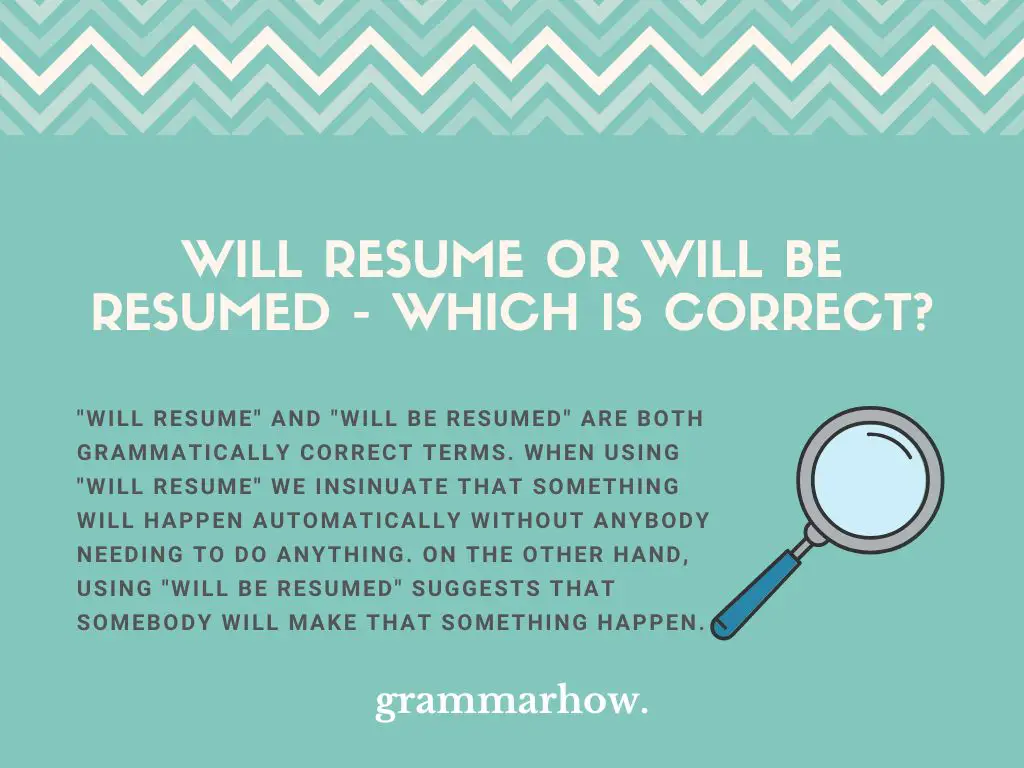
The line “will resume” indicates that a process or activity will resume regardless of what people around it do. In other words, the process will resume by itself. On the other hand, when using “will be resumed” we are giving the responsibility of resuming a process or action to someone.
Thus, the difference is small but it can be very important depending on the context. For example, in the case of a nuclear reactor, if the maintenance “will resume” or “will be resumed” makes a huge difference.
Will Resume
“Will resume” is the active form for the simple future tense. In the active voice, the noun before de verb is the one performing the action. For that reason, this verb tense implies that it will go back to what it was soon, and will happen involuntarily.
Let’s see some examples of “will resume” in a sentence:
- The strike is over. Public transportation will resume in a matter of hours.
- Don’t shut down your computer. Updates will resume as soon as the internet connection is back.
- They will resume their jobs when lunch break is over.
- The match will resume next week according to the umpires.
- I will escort Mr. Downey to the front door and we will resume our conversation.
- The machinery will resume the work, so we can go and relax in the backyard.
- Don’t worry, my team will resume the investigation, let’s go have some coffee.
Will Be Resumed
“Will be resumed” is the passive form for the simple future tense. In the passive voice, the action’s target is the focus, and the verb acts upon the subject. Hence, the verb coming after the noun is the one doing the action. It suggests that somebody will make it happen.
Let’s see some examples of “will be resumed” in a sentence:
- Congress sessions will be resumed in August.
- All commercial activities will be resumed once the hurricane has passed.
- It is expected that the negotiations will be resumed soon.
- As per the schedule, the discussion on this account is now postponed and will be resumed later.
- Family visits will be resumed as soon as Parliament delivers a clear protocol that ensures all citizens’ safety.
- The moment I heard that family visits will be resumed I was so happy I had to call all my friends and tell them about it.
- He said that the experiments will be resumed sooner or later, so I have high hopes for the future.
Which Is Used the Most?
When checking on a word’s popularity level there’s no tool more powerful than the Google Ngram Viewer . Let’s see what it says about “will resume” and “will be resumed”.
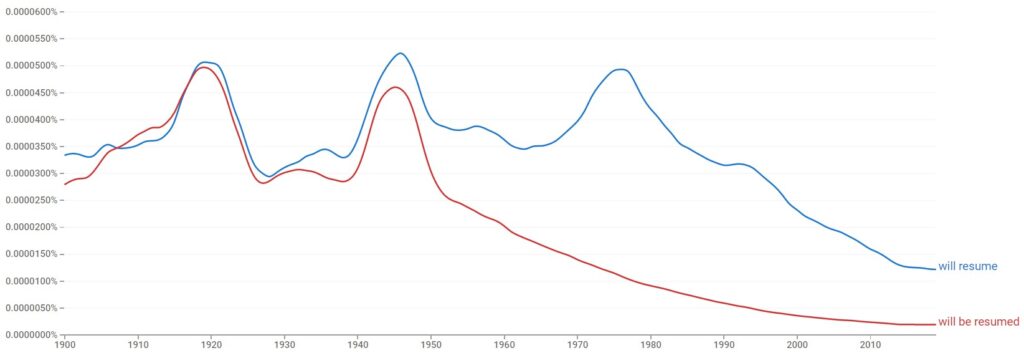
In the early 20th century, both “will resume” and “will be resumed” shared a similar usage rate. By 1920, the curves show an abrupt growth, which falls, ten years later, until returning to the initial levels. We can observe this same behavior in the 1940s, but it is from then on, that the percentage of use of both terms begins to change.
“Will be resumed” shows a smooth but constant decline to this day, resulting in a very low percentage of use. Likewise, “will resume” is now at its lowest historical percentage.
Final Thoughts
Despite showing a subtle difference in meaning due to the passive voice and active voice, “will resume” and “will be resumed” can be used as synonyms and are interchangeable. On the one hand, “will resume” implies automatism, while “will be resumed” suggests the presence of something to make it happen.

Martin holds a Master’s degree in Finance and International Business. He has six years of experience in professional communication with clients, executives, and colleagues. Furthermore, he has teaching experience from Aarhus University. Martin has been featured as an expert in communication and teaching on Forbes and Shopify. Read more about Martin here .
- “Percent” vs. “Percentage” – Correct Usage (With Examples)
- On My Resume or In My Resume – Which Is Correct?
- In Process vs. In Progress: Difference Explained (14 Examples)
- How to Put Nanny on Your Resume [Full Guide]
- Rules/Help/FAQ Help/FAQ
- Members Current visitors
- Interface Language
Follow along with the video below to see how to install our site as a web app on your home screen.
Note: This feature may not be available in some browsers.
- English Only
When will you be resuming working? When will you resume working? When will you go back to work?
- Thread starter Gabriele8512
- Start date Apr 16, 2022
Gabriele8512
Senior member.
- Apr 16, 2022
Hello! Could you, please, help me figure out which sentence sounds better in the given context? 1) So, tell me, when will you be resuming working? 2) So, tell me, when will you resume working? 3) So, tell me, when will you go back to work? Is the first sentence possible? Thanks G.
(1) is unlikely with the -ing -ing pair, which we instinctively avoid if there is an easy way to do so. The present continuous in itself is fine, though, for a planned action in the future, and so you could ask "When will you be resuming your duties?" or "When will you be going back to work?" if you think the person already knows (more or less) when they will be going back to work. If you don't expect the person know this yet, then you will probably add some other verb such as "think" or "hope": "When do you think you'll go back (be going back) to work?" or "When do you hope to go back to work?"
Aguas Claras
The natural way to say it is, I think, "when will you be going back to work?"- That being said, if you want to use "resume", I agree with Uncle Jack that it's better to avoid the double "-ing" where possible and, in this case, as "work" is also a noun, you could say "when will you be resuming work?". However, you should note that it's rather a formal way of saying it.
How to Write a Sample Email for Return to Work After Leave
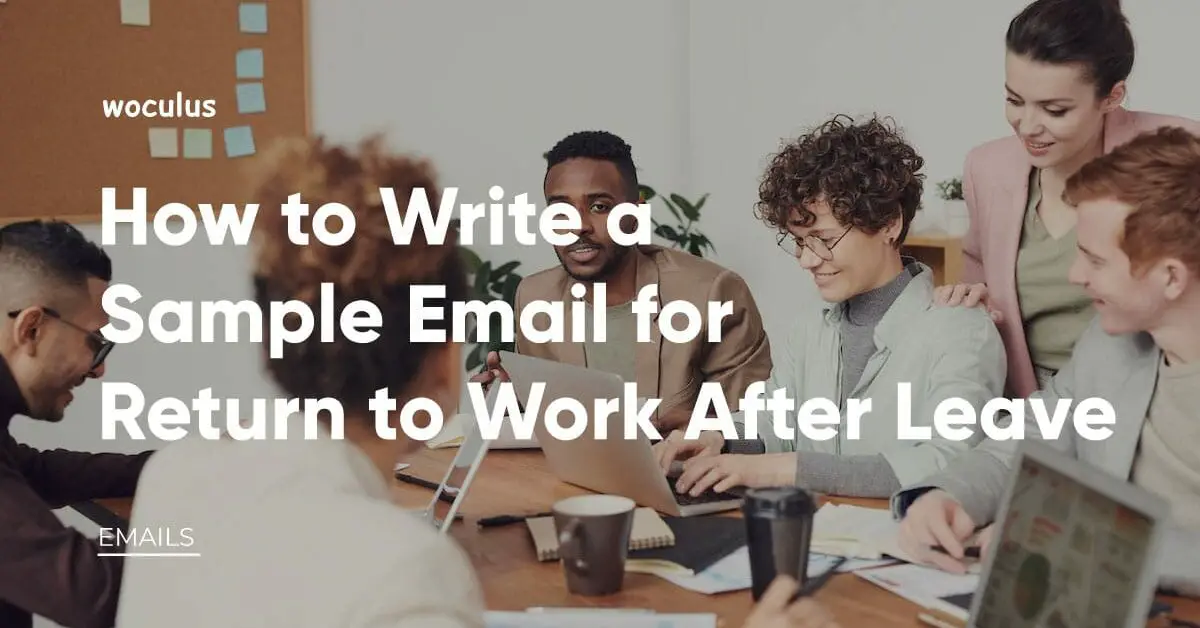
A return-to-work after- leave email is a message that informs your boss, supervisor, colleagues, and, if applicable, clients that you have returned to your regular duties. Especially if you are client-facing and manage relationships with clients on behalf of the business, it’s essential to send this email to them as well.
During your absence, your colleagues handled your clients and responsibilities. This email is your official acknowledgment and appreciation for their support during your leave. It also marks the beginning of your seamless transition back into your role, picking up where they left off.
In the workplace, employees are entitled to some paid or unpaid days off, depending on the company’s policy. There are times when you may need to temporarily leave your job, whether it’s for a medical break, a mental reset vacation, maternity leave, or to address unforeseen circumstances.
Crafting a return-to-work email is crucial for several reasons. It helps maintain a positive relationship with your manager and aligns with the policies established within your organization. Additionally, providing advance notice via email can streamline the process for employees and your HR (human resources) team when creating a return-to-work plan.
This article will share how you can draft a solid return-to-work email and tips for writing an effective one.
How to Write a Sample Email for Return to Work After Leave Email
A return-to-work email can be used as a quick refresher to address all the things that have and haven’t changed while the employee was off work.
In most organizations, HR professionals are asking for this email. They use the return-to-work notice to measure an employee’s intent on returning to work. It helps when the organization is pushed to take timely action if an employee chooses not to return at all or prefers to work remotely or part-time.
A standard return-to-work email would be achieved by following these steps:
- Subject Line: Your subject line is the header of your email. It is the first part of writing an email. Creating a short subject line would ensure your email is understandable and far from junk mail.
- Salutation: Address the receiver formally to maintain a professional tone, such as Dear [team manager] or Dear [HR manager].
- Introduction: Introduce your intent to return to work after your leave. Include important details about your time away and the return date. An overview like this would do well in reminding the manager about your absence, and it would inform them about your return to work.
- Body of the email: The following paragraph should begin with gratitude to your employer for granting the leave. You can also highlight how your absence enabled you to recover from an illness, helped you care for a new baby, or otherwise. Let your manager know if you are returning to work full-time or need a progressive transition into work, like working part-time or remotely, depending on the conditions attached to your leave.
- Depending on your job, you may send this email to more than just your boss. You may have to send it to your clients, colleagues, or other partners.
- Conclusion: Remember to thank your HR or manager for their help during your leave. Mention specific steps you want to take in your return-to-work email that would guarantee a seamless transition back to work. Make your email or include any other contact information for further communication. Insert a closing salutation, your full name, and contact details.
Tips for Writing a Return-to-Work Email
A well-written return-to-work email will help you re-align the employer with your expectations and help you adjust to the new normal at the workplace.
Below are tips to help you draft an impressive return-to-work email that makes things easier for all the parties involved.
- You should follow the general guidelines of a formal business email.
- Ask for help from coworkers, your HR department, and your supervisor if you have any questions or concerns about how you would adjust following an extended leave.
- Address the email correctly; this would differ depending on your company’s policies and structure. It can be addressed to a supervisor or human resources representative.
- Close the letter thanks to your employer for their support and flexibility during your absence.
- Use a positive tone and let your employer know how much of a help the leave has been to you.
- Communicate your fears and initiatives. Returning to work after such a long time away is not easy. Don’t expect to know everything that has gone down within that short absence. Take your time to settle down and learn about the new system.
- Attach the necessary documentation to help your transition. This is helpful if you were on medical leave and your doctor made some alterations to your work lifestyle.
Return to Work Email Example
Return to work after maternity leave email sample, i am back to work from vacation email.
Returning to work after a long break requires thorough planning and communication, especially in unprecedented times. It’s vital to let your employer know the exact date and time that you are joining the team. It eliminates any confusion and keeps your HR team and the employer on the same page.
Complete paperwork according to the updated employment laws and cooperate with the HR department and coworkers in getting themselves up to speed with the new work procedures.
About The Author
Jim Blessed
Related posts.
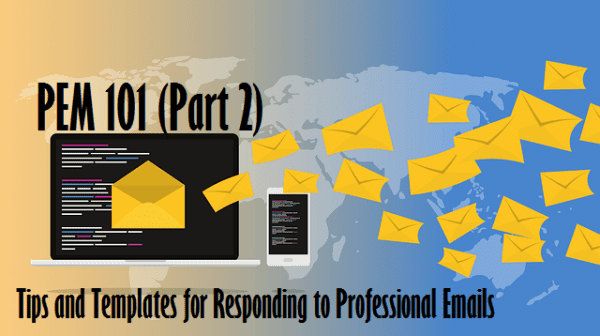
9 Tips You Need to Write and Respond to Emails Professionally
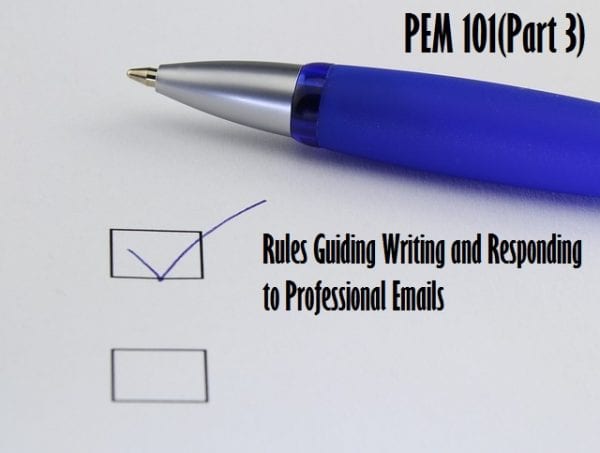
12 Rules of Writing Emails Professionally and Effectively
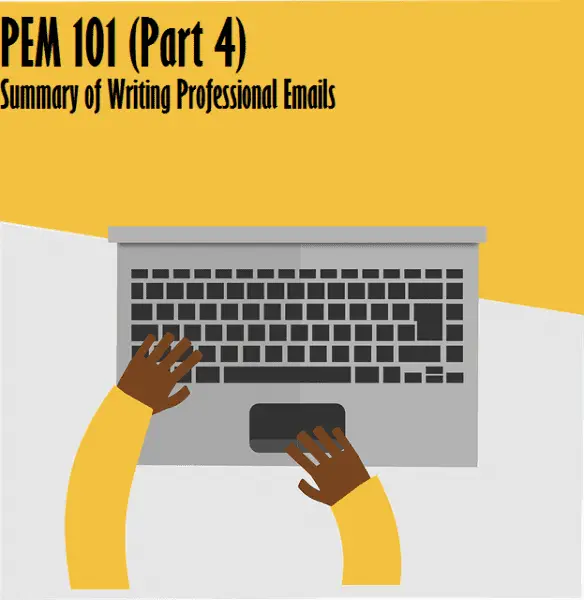
How to Write Professional Emails: 7 Critical Ingredients

8 Simple Lessons for Writing Irresistible Business to Business Emails
Leave a comment cancel reply.
Your email address will not be published. Required fields are marked *
Save my name, email, and website in this browser for the next time I comment.
- Skip to primary navigation
- Skip to main content
- Skip to footer
Attention: 4 Corner Resources is being used in a phishing scam. Read more about how to protect yourself.
4 Corner Resources
How to Create a Return to Work Resume (With Sample)
February 16, 2024 | Career Advice
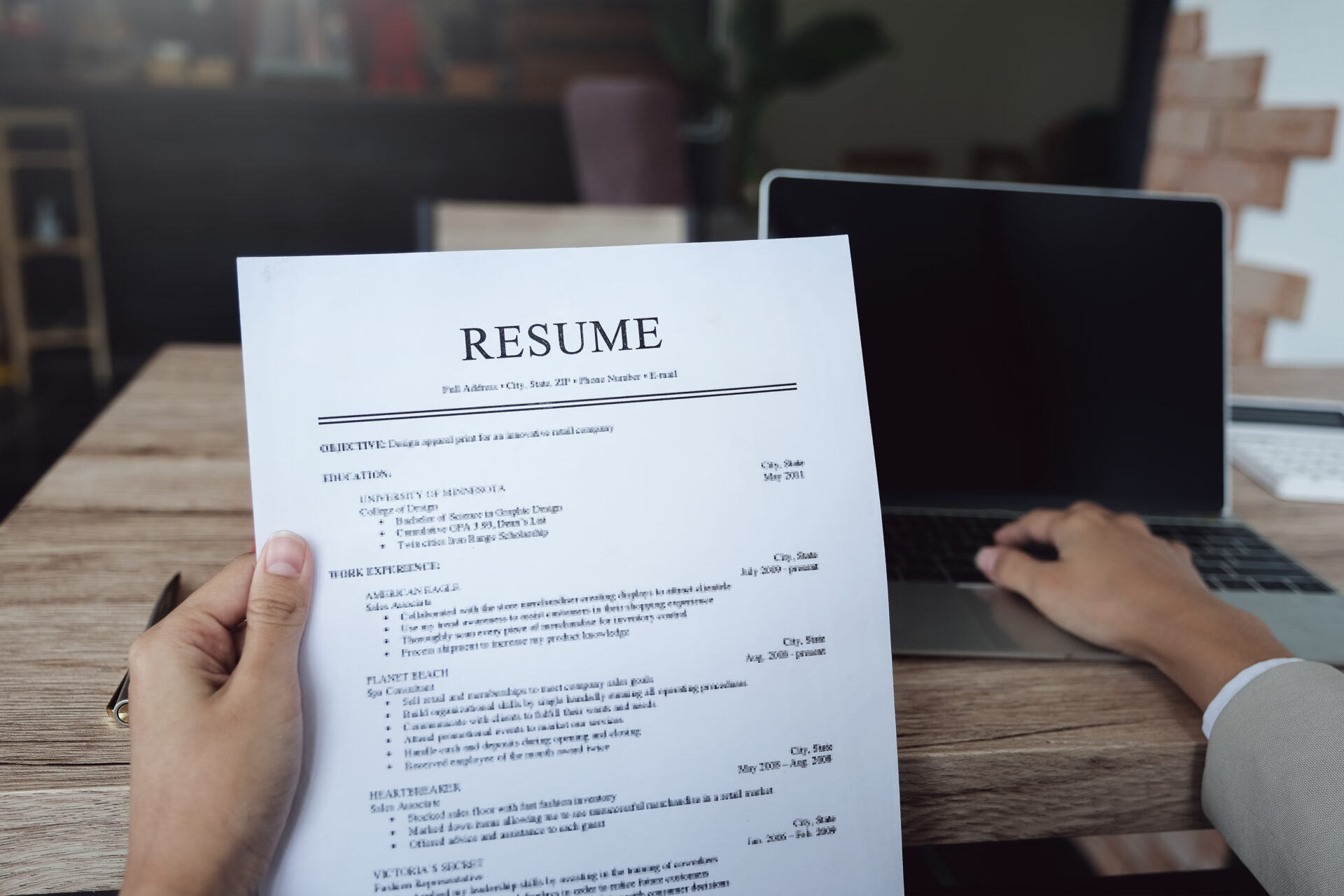
If you’re returning to the workforce after time off, updating your resume should be your first priority. Your resume will help you get your foot in the door, showcase your skills, and convince hiring managers to pick up the phone and call you for an interview.
Follow these tips to create a resume for returning to work, and use the sample resume below for inspiration as you position yourself as a standout candidate.
What to Focus on in a Return to Work Resume
Prioritizing your strengths.
Your job-specific strengths should be showcased more prominently than your work experience if you’ve been out of the workforce for a long time. It’s vital to instantly convey to hiring managers how you’re qualified for the job they’re hiring for, which can be done by moving the skills section of your resume to the top or using a format that places less of an emphasis on previous jobs (more on this below).
Modernizing your old resume
Your resume from before you left the workforce probably has a lot of good material, and your prior experience is still relevant. There’s no need to trash it and build a new resume from scratch completely. Use your old resume as a starting point, then modernize it.
The professional world has changed significantly in the last several years. Resume design norms have evolved, as has the way companies hire. Your resume should be current for the year you’re applying and adjusted to the post-pandemic world.
Why Do You Need a Resume for a Return to Work?
It’s the first thing hiring managers see.
Your professionalism and charm might help you land the job… but first, you need to get the chance to exercise them by landing an interview. Your resume is one of the first things hiring managers see when you throw your hat in the ring for an open position, so getting it right is crucial to making a good first impression and breaking back into the workforce.
Highlight your transferable skills
Since you don’t have a current job for hiring managers to go on as a reference point, you need to help them see how your skills are relevant. What makes you qualified to do the job? Your resume connects your background from your prior career and the skills you developed during your time away from the workforce to the position you want now.
When Should You Use a Return to Work Resume?
Use this resume to:
- Return to work after taking time off
- Change careers after a gap in employment
- Build professional connections that will help you land a job
Common Return to Work Resume Challenges and How to Overcome Them
Accounting for a long gap in employment.
You have two options for handling a long employment gap on a resume. Your first option is to cite it directly by listing what you were doing during that time as an entry under experience, i.e., ‘stay-at-home mom.’ This makes certain hiring managers know the reason for the gap and may keep them from making negative assumptions. Your second option is to downplay your employment gap by making other sections of your resume more prominent or using an alternative format where employment is a secondary focus, like a functional resume.
Demonstrating impressive accomplishments
It’s much easier to show how you can make an impact on an organization if you have a recent track record of closing big deals or exceeding performance goals. Since you don’t have recent work accomplishments to show, however, you’ll need to sell yourself as a candidate in other ways. Use your resume to highlight achievements and qualifications you’ve gained in other non-work experiences, such as participating in volunteer work or completing a specialized training program.
Return to Work Resume Format and Key Components
A chronological, functional, or combination resume format is a good choice for returning to work.
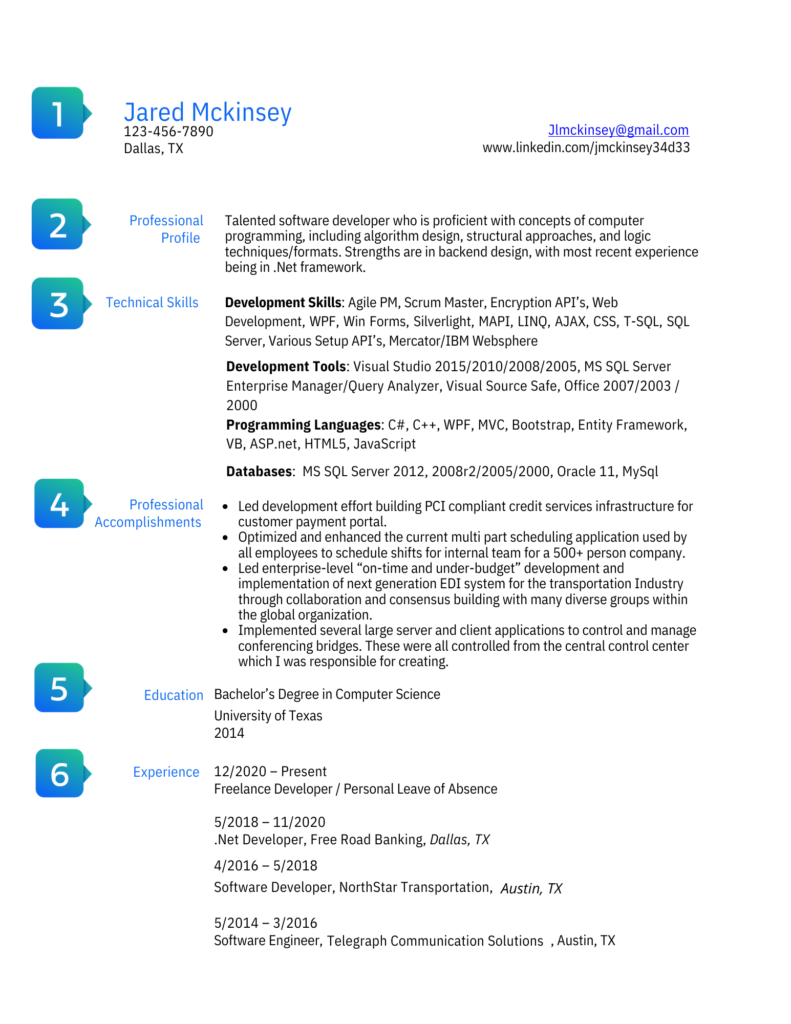
Your resume should include these components:
- Contact information Begin with your name, address, phone number, and email address.
- Summary A summary section is useful for job seekers who are returning to work, acting as your “elevator pitch” for why you’re a great candidate. Use it to sum up one to two of your strongest skills and highlight what you’d bring to the specific position and company.
- Skills Zero in on a handful of your top hard and soft skills and list them in a prominent section. As often as possible, use skills that are mentioned as requirements in the job description. This will help your resume get noticed by hiring managers and automated applicant tracking systems used to screen candidates.
- Accomplishments Share your most noteworthy work achievements that are both measurable and related to the job you are applying for. It is important to show the hiring manager that you are results-driven and have a history of exceeding expectations.
- Education List your degree and the school(s) you attended.
- Experience List your work experience in reverse chronological order. If you’re using a functional resume format, group your experience or accomplishments by type–i.e., technical experience, leadership experience, etc. Under each item, give specific, detail-rich examples of your accomplishments in that position or area, citing numbers and quantifiable achievements as much as possible.
Polishing your resume is the first step toward restarting your career a break . Make sure you’re using a modern format, customizing the document for the specific job you’re seeking, and avoiding some of the most common resume mistakes .
Just because you haven’t worked in a traditional full-time job doesn’t mean you don’t have relevant experience. In addition to listing the jobs you held before leaving the workforce, state qualifications you’ve gained during other activities that have filled your time, like serving as a caregiver or managing your household finances.
A cover letter offers a little more leeway in terms of structure and content than a resume, which makes it an ideal place to explain an employment gap and position it in a positive light.
When you’re returning to work after a long break since your last job, consider using a functional resume format. This alternative format helps call the hiring manager’s attention to your relevant skills, particularly position-specific skills like technical expertise and management experience.
When you’re reentering the job market, you can absolutely include unpaid positions in the experience section of your resume. Show how these roles expanded your skill set, brought you valuable perspective or allowed you to contribute to a worthwhile cause.
Enjoying our articles? Get the latest straight to your inbox.

About Pete Newsome
Pete Newsome is the President of 4 Corner Resources, the staffing and recruiting firm he founded in 2005. 4 Corner is a member of the American Staffing Association and TechServe Alliance, and the top-rated staffing company in Central Florida. Recent awards and recognition include being named to Forbes’ Best Recruiting Firms in America, The Seminole 100, and The Golden 100. Pete also founded ze ngig , to offer comprehensive career advice, tools, and resources for students and professionals. He hosts two podcasts, Hire Calling and Finding Career Zen, and is blazing new trails in recruitment marketing with the latest artificial intelligence (AI) technology. C onnect with Pete on LinkedIn
Related Posts

Is a Contract Job Right for You?

The Best Jobs for Stay-At-Home Moms That Pay Well

How to Write a Retirement Announcement (With Examples)
- Skip to primary navigation
- Skip to main content
- Skip to primary sidebar
512-693-7132
Packages About Testimonials

Career Pivot
Repurpose your career. Pivot now.
Get Career Pivot Insights
Back to Work: The Resumé Advice You Need to Know [Guest Post]
The resumé advice you need to know.
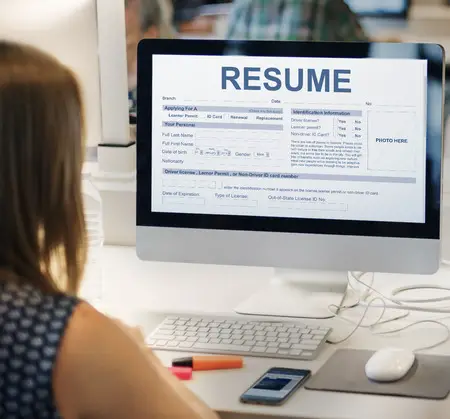
There are several reasons you may have taken a career break, whether that was to look after an elderly parent, look after children or because you were let go from another position.
Whatever your reason, it can feel daunting when you decide you’re finally ready to return to the workplace.
You might be concerned about what recruiters will think of the gaps in your resumé or feel stressed about how you should explain the gap in your career history.
But fear not – just because you took some time out, doesn’t mean you can’t get back on the career ladder! We’ve pulled together our top advice for writing a killer resumé that will get you back to the workplace in no time:
Choose the right format
The first thing you need to do is to choose the best possible resumé format. Because you’re returning to work after unemployment, this might differ slightly from the traditional resumé layout.
You should start as normal, by listing your contact details and creating a short professional profile .
You don’t need to mention in your profile that you’ve been on a break from your career – you can do this later. Instead, list your key skills, qualifications, and information about what you achieved in your previous roles. Make it short and snappy, so it grabs the hiring manager’s attention and encourages them to keep reading.
Then, continue with a core skills section, including any transferable skills you might have gained in your career break. Usually, this would be a rather short section, but after a career break, it can be helpful to place more of your focus here.
Next, move on to your employment history – this is where you will address the career gap .
Finally, you can finish off with your education section and your hobbies and interests, if you have space and feel these are relevant.

Listen to the most recent episode
Head up your employment history.
Before you begin listing your previous jobs, you should head up this section with a short explanation about why you’ve been unemployed.
This doesn’t need to be too long – just a sentence or two does the job. In fact, it’s better to keep it brief, so that the employer doesn’t spend time dwelling on it.
For example: ‘I’ve dedicated the last year caring for a sick relative. Their health has now improved and I’m eager to re-join the workforce and excel in my career.’
Then, move straight into the rest of your career history. Instead of merely listing your duties and responsibilities, focus on pinpointing results and achievements made in past roles and showcasing how you have added value to previous employers.
Honesty is the best policy
Whatever you do, do not lie about your career break. Honesty is always the best policy.
If you lie about your experience and are asked about it in an interview, you could find yourself tangled in a web of lies – and that’s a one-way ticket to rejection!
Remember, everyone has their reasons for taking some time out – and you also have the right to do so.
So, don’t be ashamed of your career break. Embrace it, put a positive spin on it and focus on showing employers what you have to offer moving forward.
Put a positive spin on things
Whether you were caring for a family member or just carefully planning your next move after being let go, there is always a way you can put a positive spin on your career break.
Were you caring for a loved one? Perhaps this taught you valuable transferable skills such as patience , compassion, and empathy – which are highly valuable in the education, care, and not-for-profit sectors.
Or, perhaps your time out allowed you to focus on your own projects or take an online course? Maybe you took the opportunity to take on some volunteer work?
You can find a way to include these positive outcomes when explaining your unemployment; proving to the employer that your career break was not a bad thing and that you continued to learn and grow your skills .
If you haven’t had a chance to upskill yet, why not start now? There are plenty of online courses available, relating to almost every career path. Have a browse, pick something relevant, get studying and then add your new-found knowledge to your resumé.
Are you ready to get back to work?
Returning to work and getting your job searching mojo back after a career break can feel daunting, but don’t let it stop you from reaching your goals.
Follow the advice above to help you craft a strong resumé that will have you back in the workplace before you know it.

This post was written by Andrew Fennell. Andrew is the writer for Assignyourwriter and founder of CV writing advice website StandOut CV – he is a former recruitment consultant and contributes career advice to websites like Business Insider, The Guardian, and Fast Company.
Like What Your Read? Get Career Pivot Insights
Do You Need Help With ...

Check out our Help Center where you have access to 14 different content portals.
Reader Interactions
February 23, 2020 at 10:40 am
Andrew, would have liked to see a straw man of this. I’ve woven this into the experience section based on other professionals advice.
I was glad you mentioned the case of continued unemployment. I wish you would have led with this and showed a solid example. The care for the sick and raising kids are well accepted in the hiring community but are overly cherry picked in articles for examples of what to say. Focus on the difficult case. Readers will appreciate that.
Search jobs
- Browse Intelligent Cloud jobs
- Browse Modern Workplace jobs
- Browse Business Applications jobs
- For Permanent job seekers
- For Contractors
- Jobs by Email
- Browse candidates
- Find candidates
- Services for Microsoft Partners
- Services for Microsoft Customers
- Submit your job
- Terms of business
- Case Studies/Testimonials
- Microsoft Cloud Careers and Hiring Guide
- Overcoming business challenges with Azure
- Overcoming business challenges with Dynamics
- Work for us
- Career Advice
8 tips for returning to work after a career break
By Lina Arshad
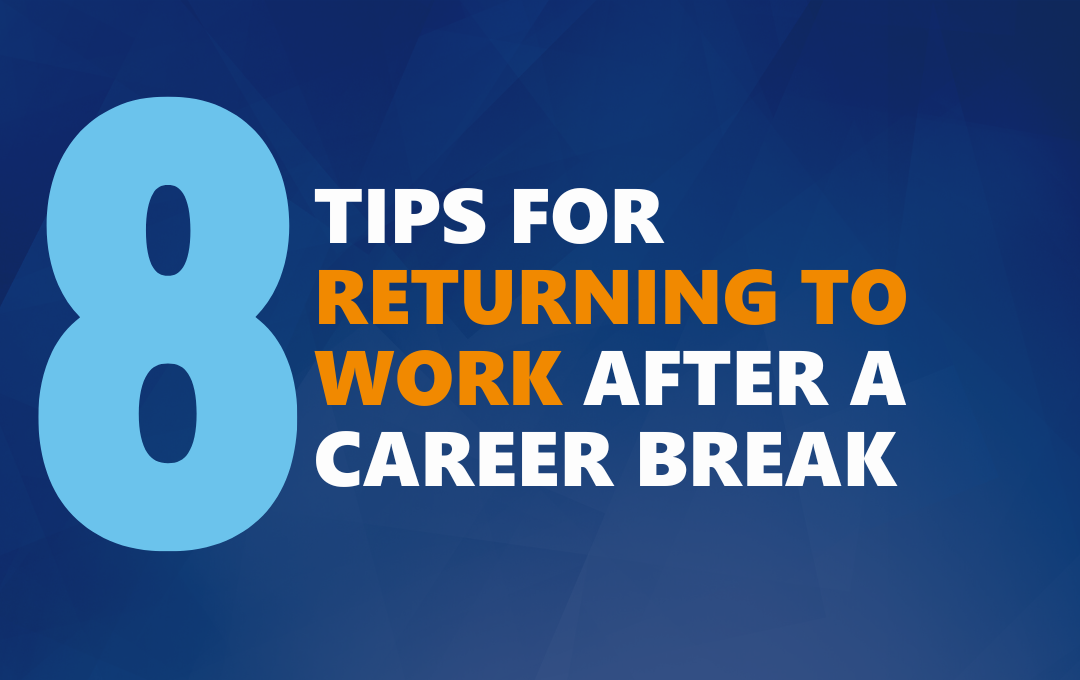
Whether you’ve been out of work for a couple of months or a couple of years, re-entering the workforce can be a daunting experience for anybody. But with unemployment figures from the U.S Bureau Labor of Statistics showing that the number of unemployed people reached 5.7 million in January 2023, being out of a job is something that impacts a vast majority of us at some point in our lives.
And while this is sometimes for permanent reasons, such as retirement, there are also times where professionals will opt to take temporary career breaks for a number of reasons, with a view to returning to the same or a different field of work in the future. Alternatively, some temporary career breaks can be down to situations outside of a professional’s control, such as redundancy, being furloughed, or a change in personal circumstance.
Whatever the deciding factor behind your career break, if you’re looking to get back on the horse this year, there are a couple of things you should be doing to ensure a seamless transition back to the working world.
Why do Microsoft professionals leave the ecosystem?
Life can be unpredictable—sometimes it requires you to completely change paths in certain aspects of your life. And for a lot of professionals, this can mean needing to take a step back and take some time to themselves to consolidate their career plan and the journey they’d like to take going forwards.
In fact, according to our Careers and Hiring Guide: Business Applications Edition 2023 , among the most common reasons that Business Applications and Dynamics professionals are leaving the Microsoft ecosystem include because of health issues (14%), for a better work-life balance (14%) , and for a career change (14%) . This is demonstrative of just how many professionals nowadays are prioritizing their health more than ever, as well as showing that employees are now more focused on finding a job that matches up to their values and expectations, rather than just settling for money—as the jobs market quickly discovered during the Great Resignation .
Whether your reasons for leaving the Microsoft ecosystem mirror those above or were for a different reason—such as expired contract (36%) , redundancy (7%) , or perhaps the job just wasn’t for you (7%) —if you’re thinking about returning to the workforce soon, you may be looking how to make your transition back into the ecosystem as smooth sailing as possible.
In the next sections, we’ll be sharing some of our expert tips and tricks for getting back to work after a period of unemployment, to make this period of change easier for you.
The return to work after a career break
The world of work has seen a major shift over the past three years, with things like remote and hybrid working dominating work trends—so much so they’re now considered an expectation rather than a perk. As well as this, many employees have a greater say when it comes to negotiating their perks and benefits packages, which is great news for you as you re-enter the global workforce!
But what else do you need to know to help you get back into the swing of things? We’ve shared our tips below.
8 tips for returning to work after a career break
- Take your time
- Assess your skills and marketability
- Narrow down your non-negotiables
- Reconnect with former colleagues and network
- Research and analyze job descriptions
- Learn new skills
- Update your resume and portfolio
- Find a recruiter to help
Returning to work when it feels like everybody around you is well-established in their careers and roles can be incredibly daunting—whether you’re returning to an industry you know well or are looking to break into an industry entirely new to you. But it doesn’t have to be.
In the following sections, we’ll be discussing some of our top tips for going back to work with a bang.
1. Take your time
We know the search for your perfect job can seem never-ending, but relieving the pressure on yourself will help significantly. When we’re busy stressing ourselves out about landing the perfect role and rushing back into work when we’re taking a break, it can lead to accepting jobs not fit for us, and even burnout—which is obviously an issue when starting a new job!
Taking time to consider why you left and took a career break will ensure you’re steering yourself in the right direction, rather than being driven into decisions by external influences and pressures. Perhaps you left because of ill health, or your contract with an organization came to an end and you wanted to regroup and rethink the services you offer.
Whatever the reason for your career break, it’s also important to reflect on what its taught you. For example, you may have learnt the importance of balancing your workload and negotiating it, rather than saying yes to picking up every task and overwhelming yourself. Or you may have narrowed down the specific part of the industry you want to be working in—or even changed your mind on the industry completely!
By being honest with yourself about the reasons you left, you have a better idea about what you want for your career beyond this employment break.

2. Assess your skills and marketability
The tech world has changed massively over the past three years, and so it’s important that any candidate looking to re-enter, or enter for the first time, has the skills to match up to the industry’s advancements.
Start by taking a look at your old resume. A lot of the skills on there will be ones you still hold, even if there are a few which need a bit of finetuning before you enter back into your field of work. You can then start thinking about any skills you’ve acquired during your time off—whether that was down to a course you took, or a hobby you turned into a venture to make some cash while you were out of employment.
Once you’ve got a list of your existing and current skills noted down, you can determine your marketability and match these up with the most-wanted skills for your industry. This can help to increase your earning potential without having to do much salary negotiation—it’s a win:win.
Just remember: soft skills are just as important as hard, technical ones in today’s working world!
3. Narrow down your non-negotiables
The employee-employer power dynamic shifted significantly under the circumstances in 2020. And with employers desperate to bridge the digital skills gap that was ever evolving during the same time, employees and candidates have since had the upper hand. This means you’re now more likely to dictate your non-negotiables, and be given them, than you were in the past.
For example, if you took time off due to health complications and will be expecting regular medical follow-up appointments, choosing a role that allows flexibility will no doubt be a key consideration for you. This may mean one of your non-negotiables is flexible start and finish hours, the option for longer lunch breaks, or even full-time remote work.
Similarly, if you’ve taken your time off to gain new skills that’ll be particularly valuable to the industry or a specific organization, you can be more particular about what salary you accept. Knowing your worth has always been important within the working world, but with candidates holding more power , it’s arguably more important than ever to ensure you get what you need and deserve from an employer.
4. Reconnect with former colleagues and network
When you leave a job, it can sometimes be difficult to keep up with colleagues who still work there or who have maybe also moved on to other jobs—but don’t underestimate the importance of it. Despite having significant job browsing options available at our fingertips on the internet and across social media, there’s every chance that a former colleague of yours may know of a vacancy for you. Plus, if they’ve worked with you before, they may be willing to make a recommendation of you or be willing to provide you with a personal reference that stands testament to your work ethic.
As well as mingling with the people you already know, it’s crucial to know just how important maximizing your network can be when you’re looking to return to work—especially for tech companies where competition for these roles tends to be stiff.
Attending Microsoft events can help you to meet like-minded professionals who may have an opportunity for you, if not now, then further down the line. Similarly, building relationships with others in the field you’re exploring gives you plenty of other opportunities to learn and develop your knowledge and skill set, so you can boost your career even further over time.
5. Research and analyze job descriptions
Once you’ve thought about the type of work you’d like to do and consolidated your skill set to ensure it matches up with the roles you hope to apply for, you can get stuck in with the nitty gritty of job searching. At this stage, we recommend simply researching companies you’d like to work with and looking at the job descriptions of open roles for positions you’d be interested in applying for.
By not jumping the gun and applying straight away, you give yourself time to see if there’s any gaps in your skill set that you could do with filling before applying for these types of positions. For example, if you’re looking for an F&O Functional Consultant position, being able to have clear strategic conversations with stakeholders will be imperative. So, if you’re not much of a speaker, taking the opportunity to attend or even present at conferences and exhibitions can show your commitment to helping the Microsoft community. If the big stage isn’t for you, you could alternatively host webinars or do live videos on your social media profile. Anything you can do to build on your existing skills to the desired level a company would want will be worth it—even if you end up accepting an offer from another company.
6. Learn new skills
As well as building on the skills you already have, taking the time to learn new skills can help you to stand out among competition in the candidate market. Think about it: if an employer has your resume and another candidate’s, and you have more relevant skills listed on your resume among great experience, they’re likely to put you ahead in their shortlist.
But it’s all too easy to simply list the skills—having proof of your knowledge is sometimes what can tip the scales in your favor. And one way of verifying your skills is by getting certified.
While certifications aren’t all the be-all and end-all, 83% of Microsoft professionals who took our survey told us that they believe getting certified makes you a more valuable candidate, while 92% believe it makes you more marketable. Regardless of whether or not this is the case across the board for hiring managers, the significance of these statistics among professionals currently in the industry is certainly something to consider.
7. Update your resume and portfolio
Once you’ve accumulated all the skills needed to get into your desired career, updating your resume with all your new skills and experience is your next port of call. Although you’ll no doubt want to fill employers in with every detail of your learning experiences, remember to keep it concise—hiring managers will have heaps of resumes to get through so short and sweet is the way to go.
If you’ve got an online portfolio of your work, remember to update that as well. Whether you insert URLs to recordings of your webinars and keynotes at conferences, or you provide links to articles you’ve written about your specialist topic, evidencing this is not just good for validating what you say in your resume, but also shows your dedication to your career.
8. Find a recruiter to help
Finding the perfect job can be difficult, especially when you’re looking for a tech job as the industry is so fast paced and there are new roles cropping up extremely often. If you’re overwhelmed when it comes to looking for your dream job, think back to the skills you’ve got and perhaps the routes professionals tend to take to get to each key role—you can find more about this in our guide.
If you’re still struggling to find the role you want without compromising on one of your non-negotiables, it may be time to find a recruiter that can help you out. Of course, you’ll need to prioritize finding one you trust and who understands what you’re looking for, but it’ll also massively help if you find one who is a specialist in your industry. For example, here at Nigel Frank we specialize in Microsoft recruitment and so each of our consultants is an expert within the ecosystem, which we consider to be a huge advantage in landing candidates jobs they love and can do with confidence—especially after a career break.
Returning to work after a career break can seem scary, but it needn’t be. By following the tips laid out in this article, you should be able to do all the background preparation to rebuild your confidence and maximize your skills and experience before you start applying for jobs again.
Need help? We’re here to help. Get in touch to speak with one of our friendly consultants for a no-obligation conversation. We have contacts across the Microsoft ecosystem who are looking to hire great Microsoft professionals just like you.
Looking to find your dream Microsoft role? We can help.
Sign up for Microsoft Azure and Dynamics tips
User type I am a... Job seeker Employer
We'd love to send you Microsoft career insights and tips by email, phone or other electronic means. We will never share your data with unauthorized third-party organisations.
- Intelligent Cloud Developer Jobs
- Intelligent Cloud Technical Consultant Jobs
- Intelligent Cloud Functional Consultant Jobs
- Intelligent Cloud Project Manager Jobs
- Intelligent Cloud Solutions Architect Jobs
- Intelligent Cloud Business Analyst Jobs
- Intelligent Cloud Technical Architect Jobs
- Intelligent Cloud Systems Administrator Jobs
- Intelligent Cloud Sales Jobs
- Intelligent Cloud Other Jobs
- Modern Workplace Developer Jobs
- Modern Workplace Technical Consultant Jobs
- Modern Workplace Functional Consultant Jobs
- Modern Workplace Project Manager Jobs
- Modern Workplace Systems Administrator Jobs
- Modern Workplace Solutions Architect Jobs
- Modern Workplace Other Jobs
- Business Applications Developer Jobs
- Business Applications Technical Consultant Jobs
- Business Applications Functional Consultant Jobs
- Business Applications Project Manager Jobs
- Business Applications Business Analyst Jobs
- Business Applications Systems Administrator Jobs
- Business Applications Technical Architect Jobs
- Business Applications Solutions Architect Jobs
- Business Applications Sales Jobs
- Business Applications IT Manager Jobs
- Business Applications Other Jobs
- SUGGESTED TOPICS
- The Magazine
- Newsletters
- Managing Yourself
- Managing Teams
- Work-life Balance
- The Big Idea
- Data & Visuals
- Reading Lists
- Case Selections
- HBR Learning
- Topic Feeds
- Account Settings
- Email Preferences
How to Address a Resume Gap When Switching Careers
- Rebecca Knight

The do’s and don’ts of navigating a career transition that’s taking longer than you hoped.
The prospect of a new career can hold a sense of excitement. But what should you do if your job search has become a disheartening slog and the gap on your resume just seems to be growing wider by the day? What can you do to protect your mental health and rekindle your optimism for the future? In this article, the author offers practical advice to help you navigate your career switch when you’re worried about a widening gap on your resume.
You likely felt a surge of excitement when you made the decision to switch careers . But what should you do if your job hunt starts to become a tedious and disheartening slog — and the gap on your resume is growing wider by the day? How can you address your extended absence from the workforce without making excuses? And how can you stay motivated and resolved in the face of setbacks?
- RK Rebecca Knight is a journalist who writes about all things related to the changing nature of careers and the workplace. Her essays and reported stories have been featured in The Boston Globe, Business Insider, The New York Times, BBC, and The Christian Science Monitor. She was shortlisted as a Reuters Institute Fellow at Oxford University in 2023. Earlier in her career, she spent a decade as an editor and reporter at the Financial Times in New York, London, and Boston.
Partner Center
- St. Petersburg
Older Floridians are going back to work as life gets less affordable
- Lauren Peace Times staff
Larry Gesick couldn’t hear his alarm, so when it went off at 5 a.m., his wife nudged him awake. A half-hour later, he was out the door — green polo tucked in, lunch cooler in hand.
While neighbors slept, Gesick ambled to his car, guided by street lamps and moonlight.
He is 77 years old, a Vietnam veteran and a great-grandfather to two. He’s also part of the fastest-growing age group in the labor force: people 75 and older.
On that early morning in March, he was on his way to Publix for work.
Americans are living longer, and for some, continuing to work in their later years is a practical choice made for mental and social well-being. But for many, like Gesick, it’s also a matter of necessity.
Seniors work because they have to afford medical bills, mortgages, food and the occasional pleasure. Because their fixed incomes and drained savings accounts are no longer enough to keep them afloat as the cost of groceries, homeowners association fees and insurance rates soar. Because they’re one crisis from financial disaster and fear they won’t be able to afford assisted living if their health suddenly declines.
So around 5:30 a.m., Gesick left the gated community where he and his wife, Joyce, bought a condo in 2021. This was supposed to be their final stop — a safe place to grow old together, where they’d spend their days riding bikes along the water and having lunch with friends.
Instead, Gesick readied himself for another eight-hour shift stocking shelves with salads and organic juices, lifting boxes of bananas and potatoes and pears.
For a time, they were retired, but it didn’t last long.
The Gesicks moved to Florida from Arizona because they reckoned it’d be nice to be near the water and because Joyce had a daughter close by.
Larry had spent decades as an electrician, Joyce as a legal assistant. Though they’d had ups and downs with money , the pair had reasoned that between Larry’s military pension and Joyce’s Social Security, they had enough to get by.
For Joyce, 67, retirement meant an opportunity to reverse the back pain and general lethargy that had built over thousands of hours at a desk job. For Larry, who had grown up on a Colorado farm, it meant rest for his body — the first since adolescence.
Spend your days with Hayes
Subscribe to our free Stephinitely newsletter
You’re all signed up!
Want more of our free, weekly newsletters in your inbox? Let’s get started.
In retirement, Larry enjoyed golfing with neighbors, retirees from Canada. Joyce liked gardening and picking her grandkids up from school.
What they loved most about retirement, though, was the time they got together. They’d take long walks and talk in a way that felt different from when they were working and tired. They had the energy to focus on each other.
But seven months in, their budget began to break. Suddenly, it seemed, everything was more expensive.
First it was groceries. Then car insurance. Then, their condo association fees shot up to $949 a month, almost double the rate from when they first moved in. Replacing aging appliances and installing hurricane windows to protect their home pushed them over the edge.
When Joyce looked over their list of monthly expenses, reality sunk in.
They couldn’t make this last.
Walk into any store and you’ll see them: older adults working the cash register at Walmart, sweeping the floor at Target, manning the paint counter at Lowe’s. The number of seniors in the American workforce is growing at a rate greater than all other age groups combined. By 2030, a U.S. Bureau of Labor Statistics report projects that nearly 12% of people ages 75 and older will be working, more than doubling the rate in 2000.
Florida is no exception.
One reason for the shift is simple: in the past, the window between retirement and death was shorter, maybe 15 years. Today, people who retire in their 60s may live well into their late 80s or 90s, so there’s a need for many to work longer.
Insufficient savings are another factor prompting older adults to keep working, said Laura Quinby, a researcher at Boston College’s Center for Retirement Research.
Nearly 80% of Americans believe there is a “retirement crisis,” according to a report released this year by the National Institute on Retirement Security . More than half fear they won’t be financially secure when they retire — if the day ever comes.
A dearth of corporate pensions and fewer employer-sponsored savings plans mean that people are getting less help from their workplace than in the past, Quinby said. At the same time, people aren’t saving on their own. More than a third of Americans said they wouldn’t be able to pay for a $1,000 emergency without borrowing or taking on debt, according to a recent Bankrate survey .
In Florida, long a haven for aging Americans with dreams of beach life on a budget, there are environmental factors adding to the financial pressures. Worsening storms have driven up insurance rates for homeowners, and state legislation requiring condos to keep reserve funds for building repairs following the Surfside collapse have contributed to the burden. Meanwhile, an influx of out-of-state residents saw housing prices soar.
For 76-year-old John DeCotret in Palm Harbor, reentering the workforce after a year away was a decision made to maintain his standard of living. He wasn’t at risk of losing his home or going without food, but his Social Security wasn’t stretching as far. He was depleting his savings and growing more nervous each day.
DeCotret, who lives in a senior mobile home park, said many of his neighbors have experienced the same.
“They’ve had to cut back,” said DeCotret. “They’ve given up their automobiles. They’ve stopped buying meats.”
Now, DeCotret is working part time as a social science researcher — the field from which he retired. Though it wasn’t his plan, he said there’s benefits to the return.
“I feel very pleased to resume working this year, for my mental health, frankly,” said DeCotret. “I feel reengaged and reinvigorated.”
In Dunedin, Denise Eberius, 65, is back at work, too.
A longtime customer service representative for Toys R Us, Eberius lost her job when the store closed in 2018. She was looking for another when her husband got cancer, and she paused her search to care for him. When he died in 2019, Eberius lost her partner of 35 years and the income from the pension he brought home as a retired police officer. She had to scramble to keep up with inflation.
“I had no choice but to go back to work,” said Eberius, who took a job as a secretary in 2021. “I never thought I’d be in this position because we were supposed to grow old together. I never thought I’d be alone.”
She said she thinks about the cost of living almost daily.
“It’s on everyone’s mind,” she said.
In St. Petersburg, 71-year-old Cindy Burns said retirement has always felt out of reach.
“I’ll likely be working for the rest of my life,” said Burns, who is preparing to become a Medicare agent after a decadeslong career in sales.
Burns is single, never been married. Though she didn’t bear the costs of raising children, she said living independently has come with a hefty price tag. And there’s no one around to split the bills.
Burns didn’t grow up with wealth, and she doesn’t have savings to fall back on.
“I have girlfriends whose parents made sure they had investments and stocks and bonds. It’s like they were given a golden parachute, and I wasn’t,” Burns said. “But I’m very upbeat. I try to make the best of it.”
So for now, she holds her head up and keeps working.
Still, the question looms: what will happen after she no longer can?
While Larry put in hours at Publix, back at the condo, Joyce Gesick sat in front of two giant monitors and scanned court filings for her remote job with a legal agency. A decorative sign with the words “SUN & FUN” and “NOT A CARE” hung at the room’s entrance.
For Joyce, returning to work came with a hint of embarrassment.
Neither she nor Larry had grown up with money. Like Burns, no one had told them what to save or how to invest. Over the years, they hadn’t splurged on fancy cars or elaborate vacations, but they also hadn’t squirreled much away.
Larry didn’t start saving for retirement until he was 50. When he got back from Vietnam, there were years lost to trauma. Planning for the future wasn’t top of mind.
Though Joyce had always been budget-conscious, a previous marriage and divorce set her back, too.
Now, each morning, when she walks the 10 feet from her bedroom to the desk in their guest room to sit for eight hours of work at $14.50 an hour, she struggles to shake the feeling of shame.
“We always tried to do the right thing, but I guess it just wasn’t enough. You wonder where the money you worked for all your lives went,” Joyce said. “It’s like we failed in some way.”
She knew they weren’t the only ones in this position, that compared to others, they were doing quite well. Still, talking about finances had always been taboo, and there was a pang of guilt that washed over her every time she said no to plans because she was working or because the money just wasn’t there.
The hardest part, Joyce and Larry agreed, was knowing that they were up against time.
So much of life felt left to chance, Joyce said. When you bought your house, when you sold. When you got into the stock market, when you cashed out. When you saved, when you splurged, and whether either was the right call.
Joyce’s ancestors hailed from Ireland, and the couple wanted to take a trip. When her grandmother was dying, she told Joyce that never visiting had been her biggest regret.
Joyce didn’t want regrets — not when it came to her time. But she also didn’t want to feel irresponsible.
So for now, she click-clacked on her keyboard. In moments when she was especially down or frustrated, she looked at the orange Post-it notes stuck to a picture frame on the nearby dresser: scrawl from Larry, reminding her she’s loved.
When Larry got home around 3:30 p.m., he idled in the kitchen while Joyce finished upstairs.
After she logged off around 4:30, they heated their dinners — pasta with shrimp, from the freezer — and ate side by side from trays propped in front of the television. A Welsh mystery played as they sat largely in silence.
These days, more than anything, Joyce and Larry miss quality time together. They yearn to be out in the world, eating pizza on the sand in Gulfport and watching $5 movie matinees. But weekdays are exhausting. By the time they make it to the end of the workday, they often opt to sit and rest at home.
It depresses Joyce to think about their time slipping away, but recently, a glimmer of hope has presented itself. She ran the numbers, and if all goes according to plan, they could have the appliances and storm windows paid off by this time next year.
That lift, she thinks, might be enough for them to retire — again.
Lauren Peace is an enterprise reporter covering issues of equity and inclusion. She can be reached at [email protected].
MORE FOR YOU
- Advertisement
ONLY AVAILABLE FOR SUBSCRIBERS
The Tampa Bay Times e-Newspaper is a digital replica of the printed paper seven days a week that is available to read on desktop, mobile, and our app for subscribers only. To enjoy the e-Newspaper every day, please subscribe.
- Share full article
Advertisement
Supported by
What Researchers Discovered When They Sent 80,000 Fake Résumés to U.S. Jobs
Some companies discriminated against Black applicants much more than others, and H.R. practices made a big difference.

By Claire Cain Miller and Josh Katz
A group of economists recently performed an experiment on around 100 of the largest companies in the country, applying for jobs using made-up résumés with equivalent qualifications but different personal characteristics. They changed applicants’ names to suggest that they were white or Black, and male or female — Latisha or Amy, Lamar or Adam.
On Monday, they released the names of the companies . On average, they found, employers contacted the presumed white applicants 9.5 percent more often than the presumed Black applicants.
Yet this practice varied significantly by firm and industry. One-fifth of the companies — many of them retailers or car dealers — were responsible for nearly half of the gap in callbacks to white and Black applicants.
Two companies favored white applicants over Black applicants significantly more than others. They were AutoNation, a used car retailer, which contacted presumed white applicants 43 percent more often, and Genuine Parts Company, which sells auto parts including under the NAPA brand, and called presumed white candidates 33 percent more often.
In a statement, Heather Ross, a spokeswoman for Genuine Parts, said, “We are always evaluating our practices to ensure inclusivity and break down barriers, and we will continue to do so.” AutoNation did not respond to a request for comment.
Companies With the Largest and Smallest Racial Contact Gaps
Of the 97 companies in the experiment, two stood out as contacting presumed white job applicants significantly more often than presumed Black ones. At 14 companies, there was little or no difference in how often they called back the presumed white or Black applicants.
Source: Patrick Kline, Evan K. Rose and Christopher R. Walters
Known as an audit study , the experiment was the largest of its kind in the United States: The researchers sent 80,000 résumés to 10,000 jobs from 2019 to 2021. The results demonstrate how entrenched employment discrimination is in parts of the U.S. labor market — and the extent to which Black workers start behind in certain industries.
“I am not in the least bit surprised,” said Daiquiri Steele, an assistant professor at the University of Alabama School of Law who previously worked for the Department of Labor on employment discrimination. “If you’re having trouble breaking in, the biggest issue is the ripple effect it has. It affects your wages and the economy of your community going forward.”
Some companies showed no difference in how they treated applications from people assumed to be white or Black. Their human resources practices — and one policy in particular (more on that later) — offer guidance for how companies can avoid biased decisions in the hiring process.
A lack of racial bias was more common in certain industries: food stores, including Kroger; food products, including Mondelez; freight and transport, including FedEx and Ryder; and wholesale, including Sysco and McLane Company.
“We want to bring people’s attention not only to the fact that racism is real, sexism is real, some are discriminating, but also that it’s possible to do better, and there’s something to be learned from those that have been doing a good job,” said Patrick Kline, an economist at the University of California, Berkeley, who conducted the study with Evan K. Rose at the University of Chicago and Christopher R. Walters at Berkeley.
The researchers first published details of their experiment in 2021, but without naming the companies. The new paper, which is set to run in the American Economic Review, names the companies and explains the methodology developed to group them by their performance, while accounting for statistical noise.
Sample Résumés From the Experiment
Fictitious résumés sent to large U.S. companies revealed a preference, on average, for candidates whose names suggested that they were white.

To assign names, the researchers started with a prior list that had been assembled using Massachusetts birth certificates from 1974 to 1979. They then supplemented this list with names found in a database of speeding tickets issued in North Carolina between 2006 and 2018, classifying a name as “distinctive” if more than 90 percent of people with that name were of a particular race.
The study includes 97 firms. The jobs the researchers applied to were entry level, not requiring a college degree or substantial work experience. In addition to race and gender, the researchers tested other characteristics protected by law , like age and sexual orientation.
They sent up to 1,000 applications to each company, applying for as many as 125 jobs per company in locations nationwide, to try to uncover patterns in companies’ operations versus isolated instances. Then they tracked whether the employer contacted the applicant within 30 days.
A bias against Black names
Companies requiring lots of interaction with customers, like sales and retail, particularly in the auto sector, were most likely to show a preference for applicants presumed to be white. This was true even when applying for positions at those firms that didn’t involve customer interaction, suggesting that discriminatory practices were baked in to corporate culture or H.R. practices, the researchers said.
Still, there were exceptions — some of the companies exhibiting the least bias were retailers, like Lowe’s and Target.
The study may underestimate the rate of discrimination against Black applicants in the labor market as a whole because it tested large companies, which tend to discriminate less, said Lincoln Quillian, a sociologist at Northwestern who analyzes audit studies. It did not include names intended to represent Latino or Asian American applicants, but other research suggests that they are also contacted less than white applicants, though they face less discrimination than Black applicants.
The experiment ended in 2021, and some of the companies involved might have changed their practices since. Still, a review of all available audit studies found that discrimination against Black applicants had not changed in three decades. After the Black Lives Matter protests in 2020, such discrimination was found to have disappeared among certain employers, but the researchers behind that study said the effect was most likely short-lived.
Gender, age and L.G.B.T.Q. status
On average, companies did not treat male and female applicants differently. This aligns with other research showing that gender discrimination against women is rare in entry-level jobs, and starts later in careers.
However, when companies did favor men (especially in manufacturing) or women (mostly at apparel stores), the biases were much larger than for race. Builders FirstSource contacted presumed male applicants more than twice as often as female ones. Ascena, which owns brands like Ann Taylor, contacted women 66 percent more than men.
Neither company responded to requests for comment.
The consequences of being female differed by race. The differences were small, but being female was a slight benefit for white applicants, and a slight penalty for Black applicants.
The researchers also tested several other characteristics protected by law, with a smaller number of résumés. They found there was a small penalty for being over 40.
Overall, they found no penalty for using nonbinary pronouns. Being gay, as indicated by including membership in an L.G.B.T.Q. club on the résumé, resulted in a slight penalty for white applicants, but benefited Black applicants — although the effect was small, when this was on their résumés, the racial penalty disappeared.
Under the Civil Rights Act of 1964, discrimination is illegal even if it’s unintentional . Yet in the real world, it is difficult for job applicants to know why they did not hear back from a company.
“These practices are particularly challenging to address because applicants often do not know whether they are being discriminated against in the hiring process,” Brandalyn Bickner, a spokeswoman for the Equal Employment Opportunity Commission, said in a statement. (It has seen the data and spoken with the researchers, though it could not use an academic study as the basis for an investigation, she said.)
What companies can do to reduce discrimination
Several common measures — like employing a chief diversity officer, offering diversity training or having a diverse board — were not correlated with decreased discrimination in entry-level hiring, the researchers found.
But one thing strongly predicted less discrimination: a centralized H.R. operation.
The researchers recorded the voice mail messages that the fake applicants received. When a company’s calls came from fewer individual phone numbers, suggesting that they were originating from a central office, there tended to be less bias . When they came from individual hiring managers at local stores or warehouses, there was more. These messages often sounded frantic and informal, asking if an applicant could start the next day, for example.
“That’s when implicit biases kick in,” Professor Kline said. A more formalized hiring process helps overcome this, he said: “Just thinking about things, which steps to take, having to run something by someone for approval, can be quite important in mitigating bias.”
At Sysco, a wholesale restaurant food distributor, which showed no racial bias in the study, a centralized recruitment team reviews résumés and decides whom to call. “Consistency in how we review candidates, with a focus on the requirements of the position, is key,” said Ron Phillips, Sysco’s chief human resources officer. “It lessens the opportunity for personal viewpoints to rise in the process.”
Another important factor is diversity among the people hiring, said Paula Hubbard, the chief human resources officer at McLane Company. It procures, stores and delivers products for large chains like Walmart, and showed no racial bias in the study. Around 40 percent of the company’s recruiters are people of color, and 60 percent are women.
Diversifying the pool of people who apply also helps, H.R. officials said. McLane goes to events for women in trucking and puts up billboards in Spanish.
So does hiring based on skills, versus degrees . While McLane used to require a college degree for many roles, it changed that practice after determining that specific skills mattered more for warehousing or driving jobs. “We now do that for all our jobs: Is there truly a degree required?” Ms. Hubbard said. “Why? Does it make sense? Is experience enough?”
Hilton, another company that showed no racial bias in the study, also stopped requiring degrees for many jobs, in 2018.
Another factor associated with less bias in hiring, the new study found, was more regulatory scrutiny — like at federal contractors, or companies with more Labor Department citations.
Finally, more profitable companies were less biased, in line with a long-held economics theory by the Nobel Prize winner Gary Becker that discrimination is bad for business. Economists said that could be because the more profitable companies benefit from a more diverse set of employees. Or it could be an indication that they had more efficient business processes, in H.R. and elsewhere.
Claire Cain Miller writes about gender, families and the future of work for The Upshot. She joined The Times in 2008 and was part of a team that won a Pulitzer Prize in 2018 for public service for reporting on workplace sexual harassment issues. More about Claire Cain Miller
Josh Katz is a graphics editor for The Upshot, where he covers a range of topics involving politics, policy and culture. He is the author of “Speaking American: How Y’all, Youse, and You Guys Talk,” a visual exploration of American regional dialects. More about Josh Katz
From The Upshot: What the Data Says
Analysis that explains politics, policy and everyday life..
Employment Discrimination: Researchers sent 80,000 fake résumés to some of the largest companies in the United States. They found that some discriminated against Black applicants much more than others .
Pandemic School Closures: A variety of data about children’s academic outcomes and about the spread of Covid-19 has accumulated since the start of the pandemic. Here is what we learned from it .
Affirmative Action: The Supreme Court effectively ended race-based preferences in admissions. But will selective schools still be able to achieve diverse student bodies? Here is how they might try .
N.Y.C. Neighborhoods: We asked New Yorkers to map their neighborhoods and to tell us what they call them . The result, while imperfect, is an extremely detailed map of the city .
Dialect Quiz: What does the way you speak say about where you’re from? Answer these questions to find out .
What to know about Biden’s new student loan forgiveness plan

President Biden is forging a new path to reduce or eliminate federal student loan balances for tens of millions of borrowers, holding firm to a campaign promise to ease the burden of college debt.
The proposed forgiveness plan announced Monday is an alternative to the sweeping $400 billion debt relief program that Biden announced in 2022 and the Supreme Court blocked last summer. Since that court defeat, the Biden administration has worked through a negotiated rulemaking process to craft a regulation that achieves large-scale debt cancellation, albeit with a much more targeted approach than the last plan.
The Education Department will release a draft rule on the forgiveness plan to solicit public comment in the coming months. But the Biden administration is releasing more details of how the proposal will accomplish the president’s goal of sweeping debt reduction.
Here’s what we know.
What does Biden’s student loan relief plan do?
The new plan will expand federal student loan relief to several categories of borrowers. It will eliminate up to $20,000 in accrued interest for borrowers who owe far more than they originally borrowed because of unpaid interest. Borrowers could get all of their interest wiped away if they are enrolled in an income-driven repayment plan and have an annual income under $120,000 for an individual or under $240,000 for couples. The White House estimates that 25 million people will benefit from this feature of the new plan, including 23 million who could have their unpaid interest completely forgiven.
Once the plan is finalized, another 2 million borrowers could automatically have their loans canceled because they’re eligible for existing forgiveness programs, such as Public Service Loan Forgiveness , but never applied. The proposed plan will also automatically cancel the loans of people who have been in repayment on undergraduate loans for at least 20 years, and graduate loans for 25 years or more. It would also forgive the debt of borrowers who attended career training programs that led to high debt loads or low earnings.
A fifth category of borrowers would receive debt relief if they are facing hardships , such as high medical debt or child-care expenses, that prevent them from repaying their student loans. The specific terms of each category will be fleshed out in the formal rule due out soon.
The administration plans to roll out the interest education feature this fall, and the remaining features could be implemented next summer.
Who is eligible for student loan forgiveness?
The majority of Americans with federally held student loans will qualify for some level of relief under the new plan. People with privately held federal loans originated through the defunct Federal Family Education Loan (FFEL) program would also benefit from some aspects of the proposal.
Those commercial FFEL borrowers would receive forgiveness if they entered repayment on or before July 1, 2000, or are eligible but have not yet applied for a closed school discharge — a form of debt cancellation for borrowers whose schools abruptly close. Such borrowers would also be eligible for debt relief if they have loans associated with a college that lost access to federal student aid because of high loan default rates, according to the Education Department.
Do I need to apply for this loan forgiveness?
While the specifics of the plan are still being hashed out at the Education Department, the Biden administration said the goal is for the vast majority of the relief to be automatic.
I was approved for loan forgiveness in the old plan. Will I qualify this time?
It depends on whether you fit any of the five categories for loan forgiveness.
How is this different from the plan rejected by the Supreme Court?
Biden’s 2022 student loan forgiveness plan relied on the Higher Education Relief Opportunities for Students (Heroes) Act of 2003, which lets the secretary of education “alleviate the hardship that federal student loan recipients may suffer as a result of national emergencies.” The president argued that the coronavirus pandemic created economic hardship for borrowers that required government intervention of up to $20,000 in loan cancellation for 40 million borrowers. But in striking down the debt plan , a majority of Supreme Court justices said the Heroes statute was not designed for policy with such a “staggering” economic impact.
This time, instead of the 2003 law, the Biden administration anchored its new plan with authority in the 1965 Higher Education Act, which allows the education secretary to compromise, waive or release loans under certain circumstances. Critics of Biden’s plan question whether the 1965 law permits expansive debt relief envisioned by the administration, and note that Chief Justice John G. Roberts Jr. said in his opinion last year that the act can be used to cancel debt in “certain limited circumstances.”
The Biden administration said the new plan is composed of interventions that address specific circumstances in ways that are covered by the Higher Education Act. The president is confident he is acting within the scope of the law, according to the White House.
Are private loans eligible?
Loans originated and held by banks and other private entities are not eligible for the new forgiveness plan. But federal loans held by private companies are eligible for some components.
Student loans
The impact of student loan repayments : A technical loophole is helping some parents lower their student loan payments . The ending of the student loan payment pause has left some borrowers anxious and confused .
What are my student loan repayment options? Personal finance columnist Michelle Singletary shares what to focus on as student loan payments resume and why she says President Biden’s new SAVE student loan income-driven plan is a game changer .
What’s next for student loan debt relief? Biden is forging ahead on a new path to narrower student loan relief after the Supreme Court rejected his earlier loan forgiveness plan . Meanwhile, conservative groups sued to block Biden’s effort to provide $39 billion in forgiveness to longtime borrowers.


- Find a Doctor
- Bariatric Weight Loss Behavioral Health Cancer Services Diabetes Services Endoscopy Emergency Care Heart & Vascular Services Home Health Hospice Imaging & Radiology Laboratory Long-Term Care Neurosciences Orthopedics Occupational Medicine Pain Medicine Pulmonary Rehabilitation Rehabilitation Research Sleep Disorders Surgery Trauma Urgent Care Women & Children Wound Healing Center
Visitation Guidelines
- Classes & Events
- Insurance & Payment
Interpreting Services
- Patient Services & Forms
Campus Maps
- Community Resources
- The Window Shops
- Gainesville
- Medical Office Buildings
- Urgent Care
- Emergency Rooms
News & Press
- Bariatric Weight Loss
- Behavioral Health
- Cancer Services
- Diabetes Services
- Emergency Care
- Heart & Vascular Services
- Home Health
- Imaging & Radiology
- Long-Term Care
- Neurosciences
- Orthopedics
- Occupational Medicine
- Pain Medicine
- Pulmonary Rehabilitation
- Rehabilitation
- Sleep Disorders
- Women & Children
- Wound Healing Center
How long will I be off work after hernia surgery?

Your doctor recommended that you have surgery to repair a hernia. But before you can schedule the hernia surgery, you need to know the answer to a key question: “How much time do I need off work?”
You might be surprised by the answer. While individual recovery time after hernia surgery will vary based on a number of factors, you could be back to work more quickly than you may think.
For robotic inguinal hernia patients, our goal is for you to be off work for one week and on light duty for one more week before returning to work at full capacity just two weeks after your surgery.
Before deciding when to move forward with hernia surgery, talk with your surgeon about your specific needs and what your recovery might look like. Each individual case is different, but there are a few general things to know about recovering after surgery.
Several factors will impact overall recovery time
Hernia surgery isn’t one-size-fits-all. How quickly you are able to resume normal activities after surgery will depend on a few different things, including:
- The type of hernia you have. There are multiple kinds of hernias. While all hernias occur when an organ pushes through muscle or tissue, the different types of hernias occur in different parts of the body. Surgical repair is slightly different for each type. Of the different types, inguinal hernia is by far the most common, accounting for 75% of all hernias.
- Your age and overall health. While every person is different, those who are younger and healthier tend to recover more quickly following any type of surgical procedure, including hernia surgery. Being older or having other health conditions can impact recovery time.
- The type of surgery performed. Recovery time will vary depending on the type of surgery you have. During a laparoscopic procedure or a robotic procedure, the hernia is accessed through several small incisions. Smaller incisions generally lead to a quicker recovery, along with reduced blood loss, less pain and a smaller risk of complications.
Recovery after surgery has multiple stages
Once your hernia surgery is complete, recovery begins. Consider it a multi-step process.
- Step one is leaving the hospital. In most cases, particularly if you have laparoscopic or robotic hernia surgery, you will be discharged from the hospital on the same day as your surgery. If the repair was more intensive than expected, you may require an overnight stay before being discharged.
- Step two involves recovery at home. During the first 24 to 48 hours after your surgical procedure, you’ll want to be especially careful, keeping an eye on your incisions and your overall health. Carefully follow the instructions from your surgeon and care team. This will include guidance about many aspects of your recovery, such as when you can shower, how to cough and sneeze without causing pain or complications, and how to care for the wound. You may experience some pain and discomfort during this time. That’s entirely normal. In most cases, this discomfort goes away as the incision heals. Your surgeon may recommend pain medication during this time. As you recover at home in the first few days following surgery, it’s good for you to get up and move around. You’ll likely feel good enough to resume most easy activities, like walking, within a day or so. Remember that even as you resume activities, you aren’t fully recovered. Full healing after hernia surgery may take up to six weeks, so you may not feel quite like yourself during this time.
- Step three of recovery can include your return to work. As you’re feeling up to it, within a few days to a couple weeks, you can gradually reintroduce other activities, including most jobs. If your work includes manual labor or requires you to lift objects, you may need to take a little longer to recover. Your surgeon can provide specific guidance on when it’s OK for you to resume your workout routine—and your work, if applicable.
The bottom line of recovering after hernia surgery is that every person’s experience is different. It’s likely that you will be able to return to work within a couple weeks following your surgery, but carefully listen to your body and the advice of your care team.
Schedule Your Appointment Today
If you are experiencing signs or symptoms of a hernia, the team of specialists at the Hernia Center of Northeast Georgia Medical Center can help. As Georgia’s first accredited Hernia Surgery Center of Excellence, NGMC offers you access to hernia specialists who offer the most advanced robotic and minimally invasive surgical techniques for hernia repair.
Call 770-219-4040 to speak to our care team about questions or to schedule an appointment.
Related articles:
Hernias 101: what they are, how they happen & how to prevent them, how to prevent a hernia, how long does it take to recover from hernia surgery.
News & Updates
Classes & Events
For Employees
Patients & Visitors
Billing Questions
Insurance Information
Financial Assistance
Login to MyChart
Patient Experience
Patient Rights & Responsibilities
Request Medical Records
Community Benefit
Give Recognition
Organization
Georgia Heart Institute
Health Partners
Register to get your text revised right away for FREE ⚡
Today more than 1001 people got their English checked.

By continuing to use this website, you agree to our Terms of Service .
Get a FREE revision 🎁
Register a new account, welcome back, confirm your email.
Please click the link that we've sent to this address to post your question to our experts. Ok, I'll check my email
not your email? Change it now
Set a new email
Here you can set your new address email. Remember to use a valid email address. We will send you an email to confirm your account.
Facebook Login Discontinued
Unfortunately, the Facebook login method has been discontinued.
To access your TextRanch account, please click the "Reset Password" button below and input your Facebook Email. Our team will send you an email with further instructions.
If you don't remember your email, please fill out this form .
Your text is being reviewed by one of our Experts. We will notify you when your revision is ready.
Or wait in this page
Leave this page open, and your corrected text will appear as soon as it's ready!

You need to add a payment method to get our special promo ⚡
Enter your email below to get instant access to the first Chapter of our Ebook
Downloaded more than 1320 times today.
Add payment method
NOTE: Credits are valid for one year.
We're so happy that you liked your revision! Your feedback helps us improve our service. Want more FREE revisions ? 🎁
Step 1 out of 2!
Like us on Facebook by clicking the like button below:
Almost there!
Last step (2/2)
Share TextRanch on Facebook by clicking on the button below.
Congrats! You've just earned 3 credits!
Closing your account will prevent you from accessing your past revisions, and you will no longer be eligible for a FREE daily revision.
There is no cost to keep your TextRanch account, and we store all of your past revisions in a secure and private manner.
Help us understand
If we didn't meet your expectations, we'd really like to know more. Please tell us why you are closing your account:
The best way to perfect your writing.
Discover why 1,026,573 users count on TextRanch to get their English corrected!
1. Input your text below. 2. Get it corrected in a few minutes by our editors. 3. Improve your English!
One of our experts will correct your English.

📝 ️Notes for your editor
Let our editor help you, include background information, explanations of unusual words and special terms, or instructions about specific improvements you want.
"will resume to office tomorrow" vs "will resume work tomorrow"
Last Updated: December 10, 2017
will resume to office tomorrow
This is not correct. Don't use this phrase.
Some alternatives from our editors:
- will resume working tomorrow
will resume work tomorrow
This is correct
Some examples from our editors:
- I had to go on leave, but I will resume work tomorrow.
- I had to take a call late this afternoon, so I will resume work tomorrow.
- I notified the human resources department that I will resume work tomorrow.
- I will start working again tomorrow
- I will resume working tomorrow
Related Comparisons
Thanks to TextRanch, I was able to score above 950 on TOEIC, and I got a good grade on ACTFL OPIC as well. + Read the full interview
I love TextRanch because of the reliable feedback. The editors' comments are helpful and the customer service is amazing. + Read the full interview
TextRanch has helped me to improve my written skills as well as to communicate more naturally, like a local English speaker. + Read the full interview
TextRanch is amazingly responsive and really cares about the client. It's the best online service that I have ever used! + Read the full interview
I started to use TextRanch when I began to learn English. It has been an awesome way to improve my English skills. + Read the full interview
I love that TextRanch editors are real people who revise the text and provide feedback – it makes it so personal. + Read the full interview
I sometimes wonder if my English expressions make sense clearly and TextRanch helps me a lot in such cases. + Read the full interview
TextRanch has been really helpful in improving the flow and repairing the structure of my sentences. + Read the full interview
“Faster than AI"
“This was very helpful and I personally think this site is the best."
“It was extremely thorough and very helpful!"
“7 years without any disappointment. Always 100% satisfied. You guys are the best in the world at what you do. Thank you so much :)"
“In a world of text messages and online communication, this is great to have as a live tool. Thank you."
“Without textranch I would be stuck!"
“Accuracy and fast response. Personal comments from editor. Thank you."
“I wasn't aware of this service, it's fascinating and more reliable than standard IA tools available on the internet"
“The fact that you can get reliable fast feedback on your texts."
“you guys are better than grammarly i'm being honest here"
“OMG! This is really good than any other text correction tools I've used so far. Highly recommend this."
“Very fast and accurate. thank you."
“I love this app because it's help to writing skills all of students ♥️"
“This was exactly the mistake I was looking for, the wording dind´t sound right at first. Better than grammarly!"
“The immediate help that I received was reassuring and very satisfactory. Thanks."
“this helps A LOT for my studies."
“Woow!! I would never have expected such precision! Thank you soooo much!!"
“Real Time Editor and not AI. Many Thanks."
“The very first thing excites me about Textranch is how much your editors care."
“The fact that texts are checked by human editors rather than by AI, etc. I appreciate this!"
“Feel welcome, immediate response, high quality feedback"
“This is the best app that I have ever seen"
“Quick response and got what I intend to say. Grammar correction is excellent because the meaning is retained."
“Excellent, I truly loved this textRanch for quick revision. This textRanch for quick revision is a 10/10 for me."
⚡️Ask our Editor now.
Fresh content for your texts, so you can be more professional.
estimated time: 30 minutes , directly in your inbox

Want to improve your English business writing?
More than 150,000 people like you receive our weekly newsletter to master their English skills!
Why choose TextRanch?
Lowest prices Up to 50% lower than other online editing sites.
Fastest Times Our team of editors is working for you 24/7.
Qualified Editors Native English experts for UK or US English.
Top Customer Service We are here to help. Satisfaction guaranteed!

COMMENTS
The difference between both is the tense. 'Will resume' is the simple future tense that implies that is will go back to what is was in the near future. While 'will be resumed' is the future perfect tense with begs the question of time. Both sentences are alluding to something restarting, the time line however begs the difference.
2. Write a resume summary. Below your contact information, write a one- to two-sentence resume summary that describes how your skills and experience make you a good fit for the position you want to apply for. This statement allows you to reveal your strongest assets and credentials right away. It is your chance to make a good impression on the ...
Will Resume "Will resume" is the active form for the simple future tense. In the active voice, the noun before de verb is the one performing the action. For that reason, this verb tense implies that it will go back to what it was soon, and will happen involuntarily. Let's see some examples of "will resume" in a sentence: The strike is ...
The second phrase, 'I will resume work tomorrow,' is the correct and more commonly used construction. The first phrase contains a few errors in grammar and word choice. 'Shall' is not commonly used in modern English, and 'to my work' should be replaced with 'work.'. Last Updated: March 22, 2024.
1. Address the letter to the correct person. Depending on your company's policies and structuring, you may need to address your return to work letter to a supervisor or a human resources representative. Whatever position this person holds in the company, they are most likely the person who coordinated your leave of absence.
Are these two sentences grammatically correct and does the meaning is same? Here are the two sentences using will resume and will be resumed.What is correct here? Also, is it true that will should always be followed by be?. 1) Or it was like I can come to New Zealand on family visitor visa again so that after completing 1 month 2 weeks, my residential visa application process will be resumed.
The natural way to say it is, I think, "when will you be going back to work?"-That being said, if you want to use "resume", I agree with Uncle Jack that it's better to avoid the double "-ing" where possible and, in this case, as "work" is also a noun, you could say "when will you be resuming work?". However, you should note that it's rather a ...
It is more common to hear someone say, "Get back to work." Or "I'm going back to work." However, in this construction, Murphy is correct, but I would use a comma after the clause: "Next week," You second sentence Would be correct like this: Next week, I'll be going back to work. Or you could say, "Next week, I'll be back on the job."
Transparency is key when going back to work after a career break. Discuss your time off in your cover letters, elevator pitches, and interviews. Your strength and confidence will rely on practice. Before even applying for a job, write out a general cover letter to help get your thoughts and story down.
Subject: Returning to Work After Maternity Leave. Dear [Supervisor's Name], I hope this email finds you well. I wanted to inform you that I am excited to return to work on [return date] after my maternity leave. I have thoroughly enjoyed the time spent with my newborn and am now ready to rejoin the team.
Determine what you want out of a job. Spend time considering what you want out of your future career. Determine what type of job you find both fulfilling and gratifying. Also, consider whether or not you want a role similar to the one you had before you took a career break, or whether you want to try something different.
AI Feedback. The part of the sentence "I will resume to work" is correct and usable in written English. You could use this phrase to let someone know that you are going to start working on something again. For example, you could say: "I was on vacation for a few days, but now I will resume to work on my project.". similar ( 58 )
"Resume" means to start doing something that you stopped doing. For example: "After my 2-week vacation, I will resume working at the office." "Return" means to physically go back to a place that you have gone to before. For example: "After my 2-week vacation, I will return to the office to work."
Education. List your degree and the school (s) you attended. Experience. List your work experience in reverse chronological order. If you're using a functional resume format, group your experience or accomplishments by type-i.e., technical experience, leadership experience, etc. Under each item, give specific, detail-rich examples of your ...
The best spot for a career break on your resume is in your experience section. To add one, follow these simple steps: Come up with a name for the "position," such as "Family Sabbatical," "Professional Development," or "Volunteer.". Where the name of a company is typically listed, add "Career Break,". "Planned Career Break ...
The sentence 'I will return to work' is correct and usable in written English. It can be used in any context in which an individual is expressing their intention to resume their job duties. For example, "I've been on vacation for two weeks and now I'm ready to go back to work. I will return to work tomorrow.". exact ( 3 )
The first thing you need to do is to choose the best possible resumé format. Because you're returning to work after unemployment, this might differ slightly from the traditional resumé layout. You should start as normal, by listing your contact details and creating a short professional profile. You don't need to mention in your profile ...
We've shared our tips below. 8 tips for returning to work after a career break. Take your time. Assess your skills and marketability. Narrow down your non-negotiables. Reconnect with former colleagues and network. Research and analyze job descriptions. Learn new skills. Update your resume and portfolio.
Or if you're considering a new career after your time off, your first step may be taking an online course. Whatever path you want to follow may be, give yourself a little push out of your comfort zone. 2. Start networking. If coming back to work involves looking for a new job, it's a good idea to begin networking.
The do's and don'ts of navigating a career transition that's taking longer than you hoped. The prospect of a new career can hold a sense of excitement. But what should you do if your job ...
"I feel very pleased to resume working this year, for my mental health, frankly," said DeCotret. "I feel reengaged and reinvigorated." In Dunedin, Denise Eberius, 65, is back at work, too.
Known as an audit study, the experiment was the largest of its kind in the United States: The researchers sent 80,000 résumés to 10,000 jobs from 2019 to 2021.The results demonstrate how ...
Work Life This is what a middle-class budget in Chicago looks like compared to Madrid, Spain Work Life From sex appeal to disparities in weight rooms: Women's sports could be entering a new era
I am off to work on my Monday morning as I was at my brother's wedding. I will resume work on Tuesday. How about this way? I attended my brother's wedding yesterday, and I am on the way to my home town. I will reach home by Monday evening and resume work on Tuesday.
Personal finance columnist Michelle Singletary shares what to focus on as student loan payments resume and why she says President Biden's new SAVE student loan income-driven plan is a game changer.
A combination format gives equal weight to work history and skills. As with the functional resume, have your skills section at the top of the page, just after the summary. List your work experience after the skills section or toward the bottom of the page. These resumes are ideal for health care professionals seeking a mid-level job title. 6.
California. Newsom orders state workers back into the office State workers will need to be in the office two days a week, according to an administration memo issued Wednesday.
Both phrases are correct, but they are used in different contexts. 'Will resume to work' is used when referring to the action of returning to work after a break or interruption. 'Will resume work' is used when referring to the action of continuing or starting work again. The choice between the two phrases depends on the specific context and ...
If your work includes manual labor or requires you to lift objects, you may need to take a little longer to recover. Your surgeon can provide specific guidance on when it's OK for you to resume your workout routine—and your work, if applicable. The bottom line of recovering after hernia surgery is that every person's experience is different.
will resume work tomorrow. This is correct. You might use this phrase if you have left the office for a period of time. Explanation provided by a TextRanch English expert. Some examples from our editors: I had to go on leave, but I will resume work tomorrow. I had to take a call late this afternoon, so I will resume work tomorrow.